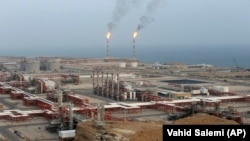The International Monetary Fund (IMF) in its Middle East and North Africa Regional Economic Outlook report says Iran needs $155 a barrel oil price this year to be able to balance its budget.
The IMF also estimates that for next year Iran would need $195 a barrel oil to raise enough revenues for government operations. Currently prices for oil similar to Iran’s crude is trading at $62 per barrel.
Iran is faced with serious economic problems since the United States imposed full oil export sanction on the county in May. Most customers have stopped buying crude from Iran. China has continued a small amount of imports but apparently it does pay any cash and takes the oil in lieu of Iranian debts.
IMF estimates a large budget deficit for Iran this year and next. For the current year and 2020, the estimate says the shortfall will be equal to 8 percent of the country’s GDP.
Iran’s current government budget is $415 billion, but this is what has been officially announced. The armed forces and intelligence organs, among others, have revenues and expenditures that remain outside of what President Hassan Rouhani’s administration manages.
IMF estimates Iran’s Gross Domestic Product (GDP) to reach $458.5 billion. Almost 9 percent of the budget was based on expected oil revenues, at 1.5 million barrels exported per day. But after full U.S. sanctions the exports have dropped below 300,000 barrels and a significant part of that is China’s imports in exchange for Iranian debt.
IMF’s estimate of Iranian oil exports this year is a bit more optimistic at 600,000 bpd, but the lower estimate of 300,000 is based on tanker traffic observed by industry intelligence firms.
The discrepancy might be partly due to oil smuggling by tanker trucks across the borders to neighboring countries such as Pakistan and Afghanistan.
Iran’s Petroleum Minister Bijan Zanganeh recently announced that Iran’s shortfall from oil revenues will reach $50 billion between March 2019-March 2020.
Earlier, IMF had estimated that Iran is in serious recession with 9.5 percent negative growth. World Bank estimates also closely match IMF figures.
U.S. sanctions also affect Iran’s banking and non-oil exports. IMF forecasts say all exports will reach just $60 billion this year in comparison with $103 billion last year.
Imports will also decrease from $86.5 billion to $73.3 billion. Iran has to import food and essential goods that it cannot produce domestically.








